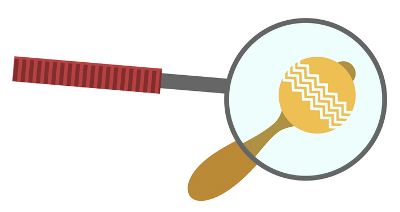
7. Rattle - 'The Sitting Room Chorus'
A few tests in other rooms proved that this was not an isolated, one-off problem. It was just more severe than most. Since then I have identified all manner of room rattle and vibration problems that degrade the sound of a Hi-Fi system and have found ways of curing them.
There are basically three categories of rattle culprits:
1. The structure - walls, floors, ceilings, windows and doors;
2. The furnishings - cupboards, radiators, gas or electric fires, cabinets, boxes, tables and chairs;
3. The ornaments - china, glassware, pictures, lights and light fittings.
I hadn't noticed the problem before because the rattling objects vibrate in time with the music and so sound as if they are coming from the loudspeakers not the room itself. This is one of the reasons why a system can sound so different in different rooms. It was also a surprise to hear how loud they were in comparison with the music that caused them. An apparently quiet bass frequency can cause a loud rattle up in the midrange or treble.
So the rattles are polluting the sound of the system even when it is played at low levels. Of course, the more powerful the system and the smaller the room, then the bigger the problem. First you rattle the contents of the room, then you rattle the structure - walls, floor, ceiling, doors.
Finding the Source of your Rattles


Using a signal generator, I found that the stimulus for all these rattles and vibrations was bass energy (frequencies up to about 200Hz). The best test equipment for finding rattles in your room is a good low distortion oscillator in its lowest band of 10Hz to 200Hz, if you are lucky enough to own one, or can borrow one.
Connect its output into the radio or CD input of your preamp, or integrated amp. Then adjust its output and your volume control so that you get a sufficiently loud sound from the loudspeakers that you can make things rattle, but not so loud that you damage the speakers, amp or your ears!
Starting at 10Hz, very, very slowly sweep up the frequency band one or two Hz at a time listening for rattles. They are quite difficult to locate because they seem to come from all directions. You will have to walk around the room to identify the sources of each rattle and probably touch items to stop and start the rattle to be certain what the real cause is. As you locate each culprit, stop it rattling in any way you can - if you can't, then remove it!
If you don't have access to a signal generator, there are useful sweep tone tracks on Richard Black's Ultimate Stereo Hearing and Equipment Refresher (USHER) CD - track 34. You should set your CD player on A-B repeat of the first 40 seconds of this track and listen for rattles as the tone sweeps up from 20Hz to 20KHz. Less convenient than being able to have a fixed frequency whilst you identify rattle culprits, but it works.
There is, however, a third way. Nature has provided you with a perfect tapping tool on the end of your wrist - your knuckle is an ideal tapper. You can rest assured that if it rattles when you tap it, it will rattle to the music!
Once you've identified the rattles, there are some very simple, invisible and effective solutions. I will describe the ones I have found to be successful - you may well find more.
Curing Structural Rattles
Walls, floors and ceilings are dealt with earlier in this article (see Room Structure here).
The most common structural rattle problems come from windows. Sash or casement windows often rattle badly in their frames and can produce very loud noises. You can adjust the positions of the catches to close the window more firmly, but a rubber strip draught excluder is usually the only way to do the job properly.
Small wooden wedges may be the only cure for sash windows because draught excluders are difficult to use on this type.
When you have silenced the frame you will probably find that the glass is slightly loose and rattling because the frame has dried and shrunk away from the putty. The best cure for this is to hook out the old putty and replace it with new - get a glazier in! An architect customer took me to task over a quick DIY tip I gave in a magazine article. He said running Superglue between the glass and the frame on the inside may cure the rattle but it makes reglazing a very much more difficult job. I agree with him so bear it in mind!
If the whole window frame rattles in the wall (I've seen it!) then consult a joiner. My architect friend will probably rap me over the knuckles for suggesting the careful use of expanding structural foam, but that's probably what a joiner would use. You must make your own judgement of your DIY capabilities.
Doors vary in their construction, but most rattle freely in the frame when shut. Draught excluders and catch adjustment will easily cure this. Modern flush doors of light honeycomb construction can often have internal rattles that are impossible to locate and fix. If you have an identical but non rattling door elsewhere in the house then replace the offender with that one, or buy a new one.
An alternative is to line the listening room side with a sheet of insulation board covered in fabric to deaden the rattles. This solution also has the benefit of reducing room 'echo' and the transmission of sound through the door. You may also notice that your room sounds better with the door closed, eliminating echoes from outside the room.
Curing Furniture Rattles
Rattling cupboard doors can be silenced with draught excluders and catch adjustment. Check that any internal shelves are not rattling too - you can stick rubber strip draught excluders on to the supports.
Pine chests or box lids are very prone to rattle but are easily cured with rubber strip draught excluders.
Look out for rattling gate leg tables (when they are folded down) and loose, dried out joints in any kind of table or chair. Dismantling and re-gluing is really a professional job, but I have found a clever DIY kit that allows regluing without first dismantling.
The glass panels in the doors and sides are prone to rattle and it is here that some very ingenious methods must be used to affect a cure. I have a suggestion to offer, but you may find a good alternative. A small piece of Blu-Tack™ squeezed into the angle between the glass and the frame at strategic points will stop the glass rattling and may also be virtually invisible. A rattling cabinet door may be cured in the same way as other doors, with rubber strips and catch adjustment.
Central heating radiators can be silenced with sound deadening pads stuck to the backs. Just slacken off the pipe nuts, lift the radiator off its wall brackets and it will hinge forward to allow you to stick the sound deadening pads on the back. One pad per foot (330mm approx) is about all you need. Watch out for minor water leaks while you do this, wrap some cloths round the pipes at each end to catch the drips.
As I have said earlier, gas and electric fires are a major cause of nasty rattles. They are made up of many metal bits and pieces that rattle against each other with gay abandon. Make sure that they are switched off before you start! Turn off the gas to gas fires and unplug electric ones.
De-rattling fires is made more difficult because, of course, they get hot, so you can't use sound deadening pads, Blu-Tack™ or other dampers that melt or cause a fire hazard. You can make simple and effective pads, spacers and wedges out of aluminium cooking foil and use your ingenuity to find ways of using them to stop the rattles. If you are really lucky, dismantling and then tightening all the screws may be all that is required.
Don't be scared to dismantle these things - most of them are made to be taken apart to replace the 'coal-effect' bulbs and for maintenance (you've heard of annual maintenance of gas fires, of course!).
Curing Rattling Ornaments
Light fittings, table lamps and standard lamps are all rich sources of buzzes and rattles. Routine tricks of tightening the screws up, wedging, packing, holt melt gluing, Blu-Tack™ will all play their part in silencing the light fitting 'sing-a-long'.
Pictures and paintings often have loose glass in the frame, and check that the frame itself is not rattling against the wall. A strip of self adhesive foam or Blu-Tack™ can be used to damp the rattle.
China plates, cups, saucers and ornaments will give you many happy silencing hours! Paper doilies between cups, saucers and plates, etc. work very well (don't forget to put them between the saucers or plates and the shelf!). Ornaments of all types can be fitted with small bits of Blu-Tack™ underneath them to kill the vibrations. My friend Chris found a clever way to stop the Blu-Tack™ sticking to the shelf or table: a dab of talcum powder to stop the 'stickiness' and, hopefully, prevent marking.
Glass benefits from the doily or Blu-Tack™ trick, but items such as bowls and jugs need to be filled with something to stop them ringing. Glass beads or marbles work well. Glasses are best filled with your choice of alcoholic beverage - my favourite is Malt Whisky. Seriously though, stand glasses upside down, the rim is then damped, preventing ringing.
If you have a cabinet displaying china and glassware, do make sure that the
glasses aren't rattling against each other. The same applies to the bottles in a drinks cabinet.
Conclusion
So, there you have it; you should now have a good understanding of what is happening acoustically in your listening room and the techniques for improving the situation. Although I have gone into some detail about the construction, size and materials to use in your room, my advice would be to go for instant gratification and tackle the simple tasks first. Set your system up and position your speakers and then tackle the rattles in your room - the 'sitting-room chorus' - and you'll be amazed at the improvement.
Once you have sorted out these relatively simple tasks, turn your attention to other fine tuning details to control reflections and flutter echoes, and look at your furnishings to control sound absorption.
Finally, consider the shape and materials used in the construction of your listening room and adjust these where necessary. I'll repeat what I said earlier: you don't have to do any of the structural work yourself - us professionals where appropriate.
Good luck!























